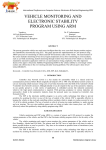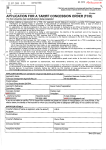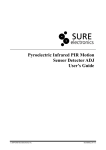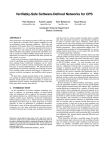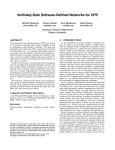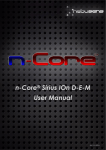Download Design And Implementation Of ARM Microcontroller Based
Transcript
ISSN (Online) : 2319 - 8753 ISSN (Print) : 2347 - 6710 International Journal of Innovative Research in Science, Engineering and Technology Volume 3, Special Issue 3, March 2014 2014 International Conference on Innovations in Engineering and Technology (ICIET’14) On st nd 21 & 22 March Organized by K.L.N. College of Engineering, Madurai, Tamil Nadu, India Design and Implementation of ARM Microcontroller Based Vehicle Monitoring and Controlling System Using Controller Area Network (CAN) Protocol Sathya Narayanan.P #1 , Ms. Monica P. Suresh, #1 Department of Electrical and Electronics Engineering, Saveetha Engineering College, Chennai, India. #2 Department of Electrical and Electronics Engineering, Saveetha Engineering College, Chennai, India. ABSTRACT— Controller Area Network (CAN) bus is a vehicle bus standard which is designed to allow microcontrollers and other electronic devices to communicate with each other within a vehicle without a host computer. CAN bus is a message-based protocol, designed specifically for automotive applications but it is also used in other areas such as aerospace, maritime, industrial automation and medical equipment. CAN is a standard protocol for efficient and reliable communication between sensor, actuator, controller and other nodes in real-time applications. This project is aimed at the implementation of CAN protocol using ARM Microcontroller for vehicle monitoring and controlling system. The main feature is to monitor various parameters such as presence of CO level, load balancing, pressure level and humidity. In this each sensed parameter is prioritized and gives the appropriate output to do the specified task. The program is compiled in KEIL µvision3 using Embedded C. Hardware is implemented and software porting is done. KEYWORDS— Controller Area Network (CAN) protocol, CO level, Load cell, Tire Pressure Monitoring System (TPMS), Automatic windshield mechanism, KEIL compiler, ARM Microcontroller CAN bus interface for sending and receiving data. CAN bus is a multi-channel transmission system. When a unit fails, it does not affect others. The data transfer rate of CAN bus in a vehicle system is different. For example, the rate of engine control system and automatic braking system is high speed of real-time control fashion of 125Kbps to 1M bps. While, the rate of movement adjustment is low-speed with transmission rate of 10 to 125K bps. Others like multimedia systems use mediumspeed rate between the previous two. This approach differentiates various channels and increases the transmission efficiency. A CAN bus is terminated to minimize signal reflections on the bus. The ISO-11898 requires that the bus has a characteristic impedance of 120 ohms. The bus can be terminated by one of the following methods: standard termination, split termination, biased split termination. There are basically four message frames in CAN: data, remote, error, and overload. The data and remote frames need to be set by the user. The other two are set by the CAN hardware. The data frame is in two formats: standard (having an 11-bit ID) and extended (having a 29-bit ID). The data frame is used by the transmitting device to send data to the receiving device, and the data frame is the most important frame handled by the user. A standard data frame starts with the start of frame (SOF) bit, which is followed by an 11-bit identifier and the remote transmission request (RTR) bit. The identifier and the RTR form the 12-bit arbitration field. The control field is 6 bits wide and indicates how many bytes of data are in the data field. The data field can be 0 to 8 bytes. I. INTRODUCTION Controller Area Network (CAN) [1] was initially created by German automotive system supplier Robert Bosch in the mid-1980s for automotive applications as a method for enabling robust serial communication. Thereafter, CAN was standardized as ISO-11898 and ISO-11519, establishing itself as the standard protocol for in-vehicle networking in the auto industry. By networking The remote frame is used by the receiving unit to the electronics in vehicles with CAN, however, they could request transmission of a message from the transmitting be controlled from a central point. By this it could unit. It consists of six fields: start of frame, arbitration increase the functionality, add modularity, and makes field, control field, CRC field, ACK field, and end of diagnostic process more efficient. frame field. A remote frame is the same as a data frame CAN bus can transfer the serial data one by one. CAN except that it lacks a data field. Error frames are bus subsystems are accessible via the control unit on the generated and transmitted by the CAN hardware and are Copyright to IJIRSET www.ijirset.com 712 M.R. Thansekhar and N. Balaji (Eds.): ICIET’14 Design And Implementation Of ARM Microcontroller Based Vehicle Monitoring And Controlling System Using Controller Area Network (CAN) Protocol used to indicate when an error has occurred during transmission. An error frame consists of an error flag and an error delimiter. There are two types of error flags. They are active and passive. The active error flag consists of 6 dominant bits, and passive error flag consists of 6 recessive bits. The error delimiter consists of 8 recessive bits. The overload frame is used by the receiving unit to indicate that it is not yet ready to receive frames. This frame consists of an overload flag and an overload delimiter. The overload flag consists of 6 dominant bits and has the same structure as the active error flag of the error frame. The overload delimiter consists of 8 recessive bits and has the same structure as the error delimiter of the error frame. II. HARDWARE A. LPC2129 The LPC2129 is based on a 16/32 bit ARM7TDMIS CPU [8] with real-time emulation and embedded trace support, together with 128/256 kilobytes (kB) of embedded high speed flash memory. A 128-bit wide internal memory interface and a unique accelerator architecture enable 32-bit code execution at maximum clock rate. For critical code size applications, the alternative 16-bit Thumb Mode reduces code by more than 30% with minimal performance penalty. With their comapct 64 and 144 pin packages, low power consumption, various 32-bit timers, combination of 4 channel 10-bit ADC and 2/4 advanced CAN channels or 8-channel 10-bit ADC and 2/4 advanced CAN channels (64 and 144 pin packages respectively), and up to 9 external interrupt pins these microcontrollers are particularly suitable for industrial control, medical systems, access control and point-of-sale. Number of available GPIOs goes up to 46 in 64 pin package. In 144 pin packages number of available GPIOs tops 76 (with external memory in use) through 112 (single-chip application). It operates on dual power supply. The CPU operating voltage range of 1.65V to 1.95V (1.8V +/-8.3%). The I/O power supply range of 3.0V to 3.6V (3.3V +/- 10%). B. CAN Tranceiver The TJA1040 [5] is the interface between the Controller Area Network (CAN) protocol controller and the physical bus. It is primarily intended for high speed applications, up to 1 Mbps, in passenger cars. The device provides differential transmit capability to the bus and differential receive capability to the CAN controller. The TJA1040 is the next step up from the TJA1050 high speed CAN transceiver. The pin diagram of TJA1040T is shown in the fig. 1. Copyright to IJIRSET Fig 1. Pin Diagram of TJA1040 The TJA1040 provides two modes of operation which are selectable via pin STB. In normal mode, the transceiver is able to transmit and receive data via the bus lines CANH and CANL. The differential receiver converts the analog data on the bus lines into digital data which is output to pin RXD via the multiplexer (MUX). The slope of the output signals on the bus lines is fixed and optimized in a way that lowest Electro Magnetic Emission (EME) is guaranteed. In standby mode the transmitter and receiver are switched off, and the low-power differential receiver will monitor the bus lines. A HIGH level on pin STB activates this low-power receiver and the wake-up filter, and after tBUS the state of the CAN bus is reflected on pin RXD. The supply current on VCC is reduced to a minimum in such a way that Electro Magnetic Immunity (EMI) is guaranteed and a wake-up event on the bus lines will be recognized. C. Gas sensor In current technology scenario, monitoring of gases produced is very important [9]. From home appliances such as air conditioners to electric chimneys and safety systems at industries monitoring of gases is very crucial. Gas sensors are very important part of such systems. The working principle of gas sensor is shown in the fig. 2. When a gas interacts with this sensor, it is first ionized into its constituents and is then adsorbed by the sensing element. This adsorption creates a potential difference on the element which is conveyed to the processor unit through output pins in form of current. www.ijirset.com M.R. Thansekhar and N. Balaji (Eds.): ICIET’14 713 Design And Implementation Of ARM Microcontroller Based Vehicle Monitoring And Controlling System Using Controller Area Network (CAN) Protocol Fig 2. Working principle of Gas sensor The gas sensor used here is MQ-6. It is sensitive to carbon monoxide, LPG, butane, propane etc. MQ 6 has 6 pin. In this, 4 pin is used to fetch signal and 2 pins are used for providing heat. Gas sensor output voltage is connected to LM358. If V+ >V then the output voltage is high and the LED connected to the output is ON. If V+ < V, then the output voltage is low and LED is OFF. Its maximum smoke level is 2000 ppm and minimum smoke level that it can able to detect is 200 ppm. MQ-6 response time is less than or equal to 10 second. D. PIR sensor A Passive InfraRed sensor (PIR sensor) is an electronic device that measures infrared (IR) light radiating from objects in its field of view [10]. PIR sensors are often used in the construction of PIR-based motion detectors. The working principle of PIR sensor is shown in the fig. 3. Apparent motion is detected when an infrared source with one temperature, such as a human, passes in front of an infrared source with another temperature, such as a wall. When a warm body like a human or animal passes by, it first intercepts one half of the PIR sensor, which causes a positive differential change between the two halves. When the warm body leaves the sensing area, the reverse happens, whereby the sensor generates a negative differential change. These change pulses are what is detected. Fig 3. Working principle of PIR sensor The PIR sensor used here is BISS0001. It can detect the range upto 20 feet ie., 6 meter. The output current produced is 10 mA. The operating temperature is from 20 ºC to 70 ºC. The PIR sensor is connected to GPIO (General Purpose Input/Output) port of LPC2129. E. Load cell A load cell is a transducer that is used to convert a force into electrical signal. This conversion is indirect and happens in two stages. Through a mechanical arrangement, the force being sensed deforms a strain gauge. The strain gauge measures the deformation (strain) as an electrical signal, because the strain changes the effective electrical resistance of the wire. A load cell usually consists of four strain gauges in a Wheatstone bridge configuration. Load cells of one strain gauge (quarter bridge) or two strain gauges (half bridge) are also available. The electrical signal output is typically in the order of a few millivolts and requires amplification by an instrumentation amplifier before it can be used. The output of the transducer is plugged into an algorithm to calculate the force applied to the transducer. The wiring of load cell consist of four wires (Plus one cable shielding, optional) is shown in the fig. 4. The wires are as below. The RED/BLACK are usually given DC excitation voltage. While the GREEN/WHITE are taken as sensing output. The load cell is connected to ADC (Analog to Digital Converter) pin and it is configured. The amount of load that is accumulated in the vehicle is displayed in LCD [11]. Copyright to IJIRSET www.ijirset.com M.R. Thansekhar and N. Balaji (Eds.): ICIET’14 714 Design And Implementation Of ARM Microcontroller Based Vehicle Monitoring And Controlling System Using Controller Area Network (CAN) Protocol driver when tire pressure is below the minimum acceptable level by illuminating a warning lamp. The pressure sensor used here is MPXY8300 series [13] shown in the below diagram. It is a 20 pin sensor to monitor tire pressure and temperature. It has 4 channel, 10-bit analog-to-digital converter. It has internal 315/434 MHz RF transmitter. The pressure sensor is connected to ADC (Analog to Digital Converter) pin and it is configured. The amount of pressure and temperature that is accumulated in the tire is displayed in LCD. Fig 4. Wiring diagram of Load cell F. Pressure sensor A Tire Pressure Monitoring System (TPMS) is a safety device that measures, identifies and warns the driver when one or more tires is significantly under-inflated. Each sensor transmits air pressure and sensor location to the vehicle’s computer. The TPMS sensor is typically located as a valve-mounted stem in the tire. The TPMS warns when one or more tires becomes25% underinflated. This can lead to decreased vehicle handling, risk of hydroplaning, diminished braking performance, uneven tire wear and shortened tire life. Rotating tires without resetting the TPMS system will set trouble codes, trigger the warning light. TPMS sensor can fail due to road hazard damage, over tightening, using an improper valve core, electronic failure and sensor battery discharge. Every tire rotation or replacement requires a sensor releam procedure. Sensors within the tire, or on the vehicle, send information to one or several modules in the vehicle. These modules are programmed with a range of acceptable circumstances. For direct tire pressure monitoring, this is often between 28 and 35 pounds per square inch (psi) of air in the tire.Many factors affect tire pressure including ambient temperature changes and tire damage such as punctures. Tire pressure drops about 1 psi for every 10 degrees F drop in ambient temperature. Additionally, tires lose as much as 1.5 psi per month as air escapes the tire and rim naturally. Fig 5. Pin diagram of MPXY8300 Humidity sensor This sensor helps to determine the amount of water vapour present in the air. When the rainfall begins, the wiper should start functioning automatically and wipe out the water present in the windshield. In this existing system the windshield should function based on the intensity of rainfall. The intensity of rain can be classified as drizzling, low rainfall, heavy rainfall. Based on the intensity of rain the speed of the wiper motor is adjusted. The humidity sensor used here is SHT25 shown in the fig. 6. The humidity range is that it can able to detect is 0 to 100% RH (Relative Humidity). It operates at the temperature of -40 ºC to +125 ºC. Tire pressure monitoring systems continuously monitor the pressure in the tires through sensors located in the tires (direct system) or the use of wheel speed and other vehicle sensors (indirect system). The information collected by the sensors is transmitted to an on-board controller that interprets the sensor signals and warns the Copyright to IJIRSET www.ijirset.com M.R. Thansekhar and N. Balaji (Eds.): ICIET’14 NC 1 VSS 2 SDA 3 S H T 2 5 4 NC 5 VDD 6 SCL NC – No internal connection Fig 6. Pin diagram of SHT25 715 Design And Implementation Of ARM Microcontroller Based Vehicle Monitoring And Controlling System Using Controller Area Network (CAN) Protocol G. LCD The LCD used here is 16 X 2. In this LCD, concentration of CO, presence of human, weight inside the vehicle using load cell, pressure inside the tire and environment humidity. These parameters are displayed in LCD to know the status inside the vehicle. LPC2129 continously sends the monitored commands and data to LCD. III. IMPLEMENTATION AND WORKING OF CAN BASED consists of logical link control (LLC) and medium access control (MAC). LLC manages the overload notification, acceptance filtering and recovery management. MAC manages the data encapsulation, frame coding, error detection and serialization/deserialization of data. The physical layer consists of physical signaling layer (PSL), physical medium attachment (PMA) and medium dependent interface (MDI). PSL manages the bit encoding / decoding and bit timing. PMA manages the driver/receiver characteristics and MDI is the connections and wires. A. CO level monitoring system MONITORING AND C ONTROLLING SYSTEM The below block diagram (Fig. 7.) shows the implementation and working of CAN based monitoring and controlling system [2]. If the air conditioner is not serviced or maintained properly and if the filter is not cleaned regularly, definitely there will be a leakage from air conditioner. This leakage may be of CO. Normally Carbon Monoxide is colourless, odourless and tasteless gas that is slightly less than air. It is toxic to humans and animals when encountered in high concentration. To avoid this problem in a vehicle, CO sensor is fixed inside the vehicle and the concentration of CO or other gases apart from oxygen is continuously monitored and displayed in LCD. The gas sensor (MQ 6) is connected to port P0.27 ie., pin no. 23. This pin is ADC ie., AIN0. The acquired concentration value is converted to a digital voltage and it is displayed in LCD. The acquired data is sent to the data bits of D0 – D7 ie., port P1.18 to P1.25. Fig.7. Block Diagram of monitoring and controlling system In this system, the different parameters such as CO level, load inside the vehicle, pressure inside the tire and environment humidity is monitoring. These parameters are implemented using CAN Bus. This monitoring system consist of two nodes and are connect by CAN Bus [3]. The various sensor used here are gas sensor, PIR Sensor, load cell, pressure sensor, humidity sensor. The two nodes are ARM microcontroller which uses LPC2129 series. The gas sensor, load cell, pressure sensor and humidity sensor are connected to ADC. The ADC converts the analog values to digital and it is displayed in LCD. PIR sensor is connected directly to a GPIO port. The values are transferred to the second node and it is displayed in a LCD. Here the CAN Bus transmit the acquired data at a speed of 1 Mbps. The communication between each parameter with the help of CAN bus can be made through the layers of OSI model. It includes the data link layer and the physical layer of the OSI reference model. The data link layer Copyright to IJIRSET Whenever the concentration of CO reached 300 ppm, the side mirror windows should slide down. When the fresh air gets accumulated inside the vehicle, the mirror windows should slide up automatically. For sliding down the mirror, the DC motor should rotate anticlockwise and for sliding up mirror, the DC motor should rotate clockwise. PIR sensor should fixed inside the vehicle and it is monitored continuously. If human is present inside the vehicle, the mirror should slide down fully. If human is not present inside the vehicle, the mirror should slide down 3 inch of it and when the fresh air get accumulated inside the vehicle the mirror should slide up automatically. PIR sensor is connected to port P0.6 ie., pin 68. PIR sensor detects the presence of human and it is displayed in LCD. B. Load balancing Load Cell detects the load level inside the vehicle and does not start the vehicle once the load exceeds. Heavy load inside the vehicle, the efficiency of an engine gets reduced and the speed of the vehicle gets reduced. This load cell is placed in-between the suspension and the weight inside the vehicle gets monitored. www.ijirset.com M.R. Thansekhar and N. Balaji (Eds.): ICIET’14 716 Design And Implementation Of ARM Microcontroller Based Vehicle Monitoring And Controlling System Using Controller Area Network (CAN) Protocol Initially the load cell is powered. The load inside the vehicle is monitored continuously and displayed in LCD. A threshold value is fixed and if it reaches above the threshold value the ignition should not happen ie., the supply from battery to ignition switch is controlled by relay. We cant able to start the vehicle. If it is within the threshold value the ignition happens. The load cell used here is single point load cell and it is connected to port P0.28 ie., ADC pin of AIN1. C. Wireless tire monitoring system The pressure and temperature of tire is monitored continuously by MPXY8300 sensor and it is transmitter to the second node of LPC2129. The monitored pressure and temperature are displayed in LCD [12]. When the pressure gets reduced in any of 4 wheels, then which tire has got puncture is displayed in LCD and nearby vehicle service station is tracked using GPS [6]. An application should be opened automatically in a display which is available in dashboard as shown in the fig.8. The sensor [13] is connected to the ADC pin of AIN2 ie., P0.29 (pin no. 32). This pin is ADC ie., AIN3. The wiper operate automatically using PWM signal by speed control IC. The wiper motor used is 12v-5W DC motor and it is mounted below the windshield. The wiper is connected to the wiper motor and it slide over the windshield. E. Implementation of CAN bus The CAN bus is implemented between the two nodes of LPC2129. The CAN bus is implemented to avoid voltage drop in transmitting the signal to microcontroller. The acquired data is transmitted at a speed of 1 Mbps. In the first node of LPC2129 pin no. 10 ie., TD1 is CAN1 transmitter output. This pin is 5V tolerant with built-in pullup. This TD1 of first node LPC2129 is connected to RD1 of second node LPC2129 ie., pin no. 9 (port P0.25). RD1 is CAN receiver input. Similarly TD1 of second node is connected to RD1 of first node. This connection is implemented and the data that is framed is transmitted and received. F. Prioritization of parameter In this monitoring and controlling system, each and every parameter is prioritized. When it is raining, the power window should slide up automatically. Meanwhile, the concentration of CO goes beyond 300 ppm (parts per million), the power window should slide down just 3 inch of it. It is not that, all four power window should slide down automatically. The PIR senor is fixed above each and every seat. If human is detected in a seat, then the corresponding power window should slide down automatically. In this situation, high priority is give to CO monitoring system. IV. CONCLUSION Fig.8. Application for pressure and temperature monitoring system D. Automatic windshield wiping system When the rainfall begins, the wiper should automatically starts function. It cleans the windshield and avoids driver intention while driving. In this existing system, the wiper motor should start wiping based on the intensity of rain inorder to avoid driver intension. The rainfall can be classified as drizzling, normal rainfall and heavy rainfall. If it is drizzling, the wiper motor functions very slowly. If it is normal rainfall, it should wipe at normal speed. If it is heavy rainfall, it should wipe very fast. The humidity sensor [14] is placed outside the vehicle to monitor amount of air present in the atmosphere. Three threshold value is fixed for the classification of rain. If the power window is opened when drizzling or normal rain or heavy rain, it should slide up automatically. The sensor used here is SHT25 humidity sensor. The humidity sensor is connected to port P0.30 ie., pin no. 33. Copyright to IJIRSET The parameter in a vehicle is monitored and necessary control has been made for each parameter by using CAN protocol. The concentration of Carbon Monoxide (CO) is maintained below 300 ppm, to avoid breathing problem while inside the vehicle. The load inside the vehicle is maintained below 1000 kg, to avoid the reduction in efficiency of an engine, limitation in speed and number of death if an accident occur. The pressure and temperature of a tire is monitored continuously and its threshold value is maintained. If it is below the threshold value, then the nearby service station is tracked using GPS. The amount of water present in the atmosphere is monitored and the wiper motor functions based on the intensity of rain using PWM signal. The sensors used are CO sensor, PIR sensor, load Cell, pressure sensor and humidity sensor. The different parameters are monitored using these sensor and are displayed in LCD. A closed loop control has been made for these parameters and each parameters are prioritized. REFERENCES [1] Presi.T.P, “Design And Development Of PIC Microcontroller Based Vehicle Monitoring System Using Controller Area Network (CAN) Protocol”, Information Communication and Embedded Systems -(ICICES) pp.1070-1076, 2013. www.ijirset.com M.R. Thansekhar and N. Balaji (Eds.): ICIET’14 717 Design And Implementation Of ARM Microcontroller Based Vehicle Monitoring And Controlling System Using Controller Area Network (CAN) Protocol [2] Piao Chang-hao, Chen Lu, Cao Ju, “A Design for Controller Area Network Bus Real-Time Monitoring System”, Computer Science and Network Technology (ICCSNT) pp.1621 – 1624, 3(2011). [3] Renjun Li, Chu Liu and Feng Luo, “A Design for Automotive CAN Bus Monitoring System”, IEEE Vehicle Power and Propulsion Conference (VPPC) pp.1-5, 2008 [4] Jong Man Jeon, Dae Won Kim, Hong Seok Kim, Yong Jo Cho, Beom Hee Lee, “An analysis of network-based control system using CAN(controller area network) protocol”, Robotics and Automation, 2001. Proceeding 2001 ICRA. IEEE Internation Conference pp.3577-3581, 4(2001). [5] TJA1040 High speed CAN tranceiver datasheet. [6] Hui Hu, “Design and Implementation of Vehicle Monitoring Based on GPS/GSM/GIS”, Intelligent Information Technology Application pp.278-281, 3(2009). [7] Andrew N.SLOSS, Dominic SYMES, Chris WRIGHT, “ARM System Developer’s Guide Designing and Optimizing System Software”, ISBN: 1-55860-874-5, Elsevier Books. [8] LPC2119/2129/2194/2292/2294 User manual, Philips Semiconductor. [9] MQ – 6 Gas sensor datasheet. [10] BISS0001 Micro power PIR motion detector IC datasheet. [11] Stuart R. Ball, “Analog Interfacing to Embedded Microprocessors Real World Design”, ISBN: 0-7506-7723-6, Elsevier Books. [12] Hasan N.N, “Implementation of Tire Pressure Monitoring System with Wireless Communication”, Communications, Computing and Control Applications (CCCA) pp.1-4, 2011 [13] MPXY8300 Tire Pressure Monitor Sensor Product Specification datasheet. [14] Ka C.Cheok, Kobayashi K, Scaccia.S, Scaccia.G, “A Fuzzy Logic Based Smart Automatic Windshield Wiper”, IEEE Control Systems pp. 28 – 34, 6(1996). Copyright to IJIRSET www.ijirset.com M.R. Thansekhar and N. Balaji (Eds.): ICIET’14 718







